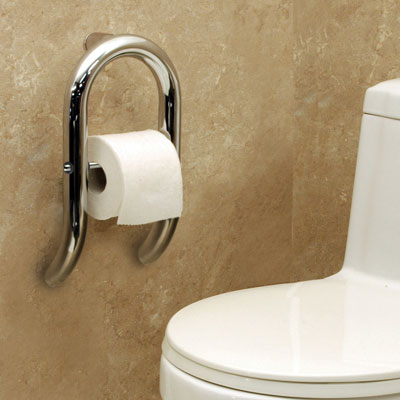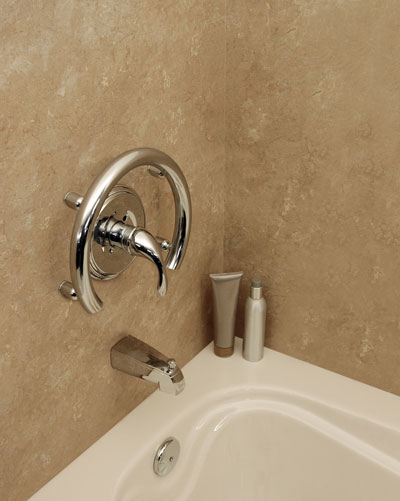We all understand the importance of bathroom safety, and grab bars, if placed properly, help keep people safe. While we often think of falls in the bathroom as an issue only for the elderly, it is a problem we all face daily. A slippery surface combined with wet and soapy conditions can lead to a fall and injury for anyone. According to a Centers for Disease Control and Prevention (CDC) study, nearly a quarter of a million Americans age 15 and older fall in the bathroom every year. That’s a staggering number when you consider how a fall can affect quality of life—regardless of age—and how preventable most falls can be. The same CDC report contains equally alarming information:
- In 2010, direct medical costs related to falls were $30 billion
- One out of every three adults aged 65 and older falls every year
- In 2010, 2.3 million fall injuries among older adults were treated in emergency rooms
However, despite all the risk and evidence of injury, it is difficult to convince a client to install a grab bar. Perhaps that’s because of pride, vanity or stubbornness, but no one wants their home washroom turned into a hospital environment. And they are absolutely right—there is no need to put a grab bar in your clients’ bathrooms. Caught your attention?
 There is a new category of decorative bathroom safety products on the market and their aim is to replace traditional grab bars. These safety enhanced bathroom accessories include soap dishes, corner shelves, towel bars, toilet roll holders and bath seating, all designer items that happen to be grab bars and bath safety products hidden in plain sight. As the CDC report indicates, a fall can happen at any age. Whether a teenager getting ready for school, 30 and expecting a baby, 50 and needing a little extra support getting off the toilet or 75 with a full-fledged fall risk, any customer can use these accessories. The appeal of these products derives from:
There is a new category of decorative bathroom safety products on the market and their aim is to replace traditional grab bars. These safety enhanced bathroom accessories include soap dishes, corner shelves, towel bars, toilet roll holders and bath seating, all designer items that happen to be grab bars and bath safety products hidden in plain sight. As the CDC report indicates, a fall can happen at any age. Whether a teenager getting ready for school, 30 and expecting a baby, 50 and needing a little extra support getting off the toilet or 75 with a full-fledged fall risk, any customer can use these accessories. The appeal of these products derives from:
Safety—Keeps clients safe with weight capacities up to 500 pounds, while building support into each accessory that is intuitive to grab onto for leverage and support.
Design—Clients do not want to install a grab bar into their bathroom. What is the solution? Make them want to install the products into their bathroom. By disguising the safety features while customizing the accessory finishes (i.e. brushed nickel, polished chrome, etc.), you can create a stylish, inviting and healthier safety environment.
One of the leaders in this new type of decorative bath safety product is the Invisia Collection by HealthCraft. “When designing the Invisia Collection, we set out to change the mindset of putting a safety product into a bathroom after you already need it, to putting a safety product in before you need it,” says Jason St. Amant, sales manager for HealthCraft Products and the Invisia Collection. “We created the Invisia Collection to introduce a line of luxury bathroom accessories that just happen to be grab bars hidden in plain sight. We want to make bathroom safety beautiful, so it is accessible for everyone… regardless of their age or need.”
 Since the decorative bath safety business is quickly developing into a highly profitable and growing cash sales market, it is important to maximize your business opportunity. Partnerships with contractors and designers are natural—they have aging clients to serve, but not the professional knowledge to support them. An HME provider fills that role and can generate cash sales immediately from a new customer base. “Be careful when choosing a product line,” St. Amant warns. “Some of the decorative bath safety products on the market are also sold at big box retailers. It can be difficult for an HME to compete, but a big box hardware store isn’t an expert in safety, and they don’t understand their clients complete safety needs. HMEs are the top of the food chain when it comes to knowledge, care products and supporting client needs.”
Since the decorative bath safety business is quickly developing into a highly profitable and growing cash sales market, it is important to maximize your business opportunity. Partnerships with contractors and designers are natural—they have aging clients to serve, but not the professional knowledge to support them. An HME provider fills that role and can generate cash sales immediately from a new customer base. “Be careful when choosing a product line,” St. Amant warns. “Some of the decorative bath safety products on the market are also sold at big box retailers. It can be difficult for an HME to compete, but a big box hardware store isn’t an expert in safety, and they don’t understand their clients complete safety needs. HMEs are the top of the food chain when it comes to knowledge, care products and supporting client needs.”
All businesses are seeing their client base age, so by reaching out to partner with your local designers and contractors, you position yourself as the universal design and aging in place specialist for your community. Reaching out to educational program directors and facilitators only reinforces your brand and promotes future business. With 77 million aging Baby Boomers in the U.S., the expectation is that bath safety products will evolve to suit their needs—this is one demographic that won’t necessarily accept traditional product offerings. The Baby Boomer market represents a formidable customer base, and now is the time to act to earn their business.
